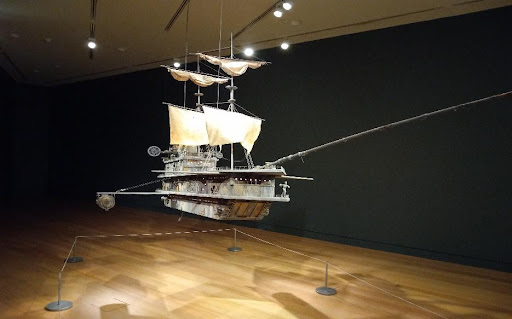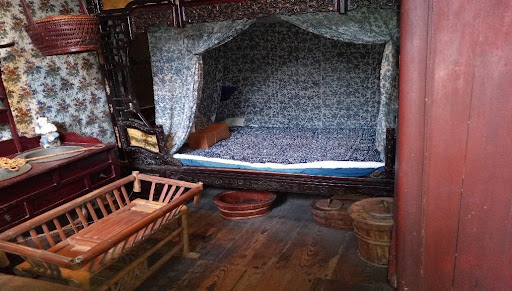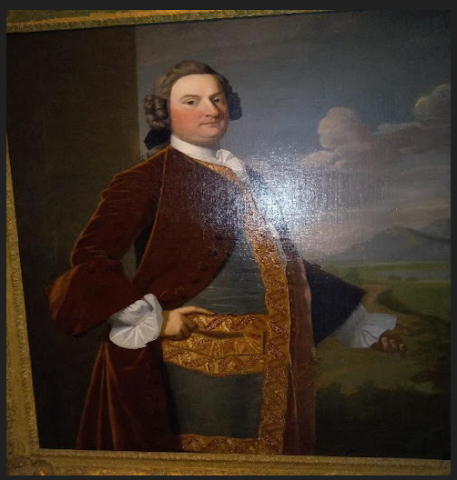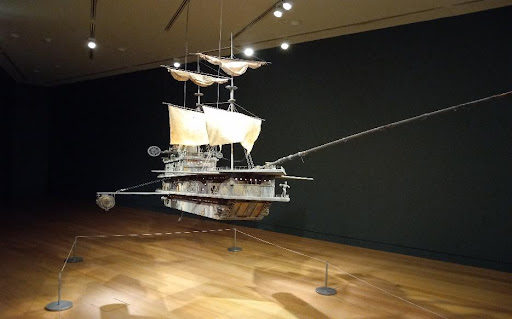Professor Whitfield focuses on the important role and value of small American museums. In his travels, he participates in marathons and visits museums. In a series of articles, he writes about very special small to mid-sized museums, “the hidden gems”.

Pequod II, Michael C. McMillen’s haunting, harrowing and eerily beautiful metallic and wood sculpture. Is it a spaceship, flying aircraft carrier or a ghost? Or, is it ghastly metaphor for a great nation whose best days have passed?
You’re in Boston, Massachusetts. Maybe you’ve come to attend the Boston Symphony Orchestra or see the Red Sox play at historic Fenway Park. Maybe you want to see the Old State House where the Boston Massacre occurred, and a new nation was soon to be born. Certainly, there are many world class attractions. However, if you want a change of pace and want to get out of the city for one day, take a trip to Salem, Massachusetts. Yes, that Salem, site of the infamous witch trials in 1692. We will talk about the witch museums and exhibits on another day. Today, our focus is The Peabody Essex Museum, the oldest continuously operating museum in the United States, and another hidden gem.
At a distance of roughly 22 miles, traveling from Boston to Salem is convenient. You can drive or even take a high speed ferry ($27.50/adult). While planning my visit, I encountered a very, very unusual problem; my wife was with me. Her idea of a good time on a Sunday is to attend church for 10 hours if she could; she would have fit perfectly within any 17th century Puritan community. So, what was the problem we encountered, you may ask. My wife would not stay in Salem! She was worried that perhaps, just perhaps there had been real witches in Salem, and maybe, just maybe their spirits were still active. Every attempt to calm her fears failed. Every appeal to reason was rejected.
“If passion rules, how weak does reason prove!” – John Dryden
So, we compromised, rather I compromised, and we stayed outside of Salem. To my wife’s credit, The Doubletree by Hilton hotel in Danvers, MA was an excellent choice.
It was late on a Sunday afternoon when we arrived in Salem. My first stop was the Visitors Center to find out which of the “witch” related museums they recommended. There I met Park Ranger Charlie Wilson. In addition to being warm and welcoming, the man is a living encyclopedia of knowledge regarding the history of Salem. Charlie thoroughly discussed the various “witch” attractions and then added, “You know, Salem has a rich 400-year maritime history. You might want to see some of those sites too.” For the next ten minutes, he discussed Salem’s maritime historical importance and several attractions to consider. It was fascinating. At the end of our discussion, he walked out of the center with me and pointed to the Peabody Essex Museum. Thank you Charlie Wilson!
On Monday, I arrived at the Peabody Essex Museum (PEM) at 12:52pm. Earlier that morning, I visited The Witch Dungeon, but that’s a story for another article (Quiet! Don’t tell my wife!). After entering PEM and purchasing a ticket (adults $20, seniors $18, students $12, youth 16 and under free), you immediately find yourself in a large atrium; it’s bright, full of life and filled with light permitted in by glass ceiling panels. The atrium features seating, dining facilities and a gift shop. Masks are encouraged.
PEM traces its history back to 1799, when prominent Salem captains established the East India Marine Society. The society had a dual purpose, to assist disabled sailors and their families, as well as promote knowledge of navigation and trade to the East Indies. In 1867, the Academy of Science acquired the East India Marine Society and the Essex Institute. Given PEM’s maritime origins, one would expect to find captivating ocean related exhibits – and they are there, including a huge leatherneck turtle donated in 1885 that dripped oil for 100 years, and the full skeleton of a long-finned pilot whale collected in 1873.
One would also expect enchanting works of art from the far east – and they are there in abundance. But there are also wonderful surprises, such as the Yin Yu Tang exhibit, a complete 16-bedroom house built by a wealthy merchant in China during the early 1800s. Over a five-year period, the two-story structure was disassembled piece by piece and reconstructed at PEM as an exhibit. Some say time travel is possible; others say it is not.
Nevertheless, walking through each room of the house, climbing the stairs, seeing the ancient kitchen, all the bedrooms, meeting areas and courtyard somehow transport you. Part of the magic of some museums is that they allow us to time travel, not with a time machine, but with something far more fascinating, the human mind. Museums allow us to feel some part of the past.
“I want to go back in time, not to change anything, but to feel something again.” – Mercer.

Bedroom and baby crib (Yin Yu Tang exhibit)
Of all the moving PEM exhibits, two invaded my consciousness and have not let go. One was Native and American. The second was Pequod II. The term Native American is quite common. Initially, you do not pay too much attention to the conjunction “and” in the exhibit’s title Native and American; it’s subtle but evocative.
Are both words adjectives? Are they both nouns; what’s going on here? As you enter the exhibition, there’s a temptation to think the focus will be on America’s first human inhabitants, and then something hits you. One of the first exhibits is a large oil on canvas portrait (1750ish by Robert Feke) of Judge Richard Saltonstall.
What’s going on here? He’s standing and looking somewhat toward the direction of his right shoulder, with his right hand resting on his waist and slightly holding back his coat. Saltonstall looks like quite the 18th century gentleman. He’s dressed in a rouge velvet coat, with a long green vest embroidered with ornate golden trim. But he’s a white guy, not a Native American. What’s going on here?

Judge Richard Saltonstall by Robert Feke
The next eight items are large, crisp black and white photographs of members of the Wampanoag tribe. Included are adult men, women and several children. At first it is difficult to tell exactly when the photographs were taken, but two clues give them away, first the very modern fashion of the children’s clothes and secondly the sharpness of the photographs. Only at the end of this section do we learn that photographer Will Wilson, shot the series in 2019, but with a 19th century camera and a 21st century lens.
Much of the rest of the exhibit focuses on three themes (fashion, furniture and family bonds of love) and follows a similar pattern of placing art from one American community in close proximity with art from an entirely different American community. The sharp contrast of art from different American cultures, but all sharing common themes, forces one to consider a larger picture. Perhaps all humanity is seeking or searching for the same ends, goals or meaning in life.
The exhibit doesn’t avoid the original twin-sins of our country, slavery and the treatment of native Americans. In the Fringe, a 2008 painting by Rebecca Belmore of the Aniishinabe people, we see what appears to be the scarred back of a native American woman lying on her side. The scar begins at the top right shoulder and runs diagonally stopping on her left side at the waist. Along the way roughly 25 lines of blood drip off her back and down towards the surface she is laying on. Upon closer inspection we realize the scars and blood are actually red beads. The painting simultaneously acknowledges the demands and creativity necessary to build a brighter future with the inferno of wrongs from the past.
Finally, the Pequod II, Michael C. McMillen’s 1987 metallic and wood sculpture, constructed from what could be spare parts from a junkyard. Set alone in a room is what seems like a spaceship, or is it a flying aircraft carrier, or a ghost? It is suspended from the ceiling by cables.
There are two decks and a bridge, but something is odd about this spaceship. It also has four sales that are similar to what were seen on large wooden naval or cargo ships of the 18th century. The bottom sales are fully expanded; the smaller top sales are still folded. Additionally, it has jet-like wings! Under the outermost part of each wing are cylindrical structures similar to propulsion devices seen on large commercial jets.
Despite its futuristic appearance from afar, closer inspection reveals the Pequod II is old, rusted, tired and possibly has run its course. Why the title Pequod II? The Pequod is the doomed whaling ship from Herman Melville’s masterpiece Moby Dick. Is the Pequod II a ghostly metaphor of America? Is it suggesting we have seen our best days? Are we doomed? Are we as a nation suspended in space?

The Pequod II by Michael C. McMillen
Is the rust and baggage from our past preventing us from transitioning to the future? Or, is this suspension a time to reflect and correct our course? Are our best days ahead of us? Great art touches our emotions. It can also force us to ask hard questions that may have frightening answers. What does the Pequod II say to you?
The Peabody Essex Museum is a hidden gem. https://www.pem.org/

MuseumsMarathonMan@gmail.com | https://www.twitter.com/MuseumMarathon1
https://www.facebook.com/MuseumsMarathon1 | 516 909-1874
Bentley Whitfield is a professor of comparative literature with the State University of New York (SUNY), the largest comprehensive public college system in the USA. He is a recipient of the Chancellor’s Award for Excellence, one of SUNY’s highest honors. In his travels he participates in marathons and visits museums. In a series of articles, he writes about very special small to mid-sized museums, “the hidden gems”.
Media Contact
Company Name: The Peabody Essex Museum
Contact Person: Bentley Whitfield
Email: Send Email
Country: United States
Website: https://www.pem.org/
